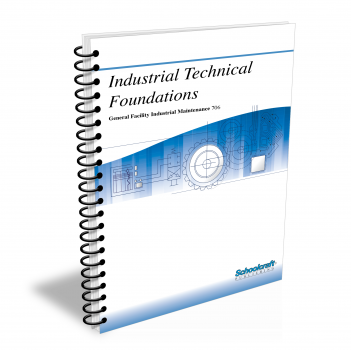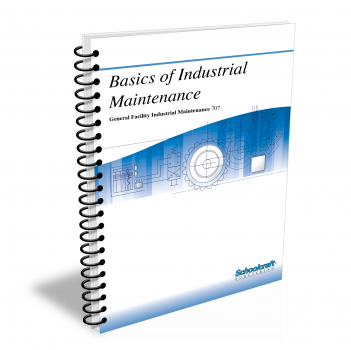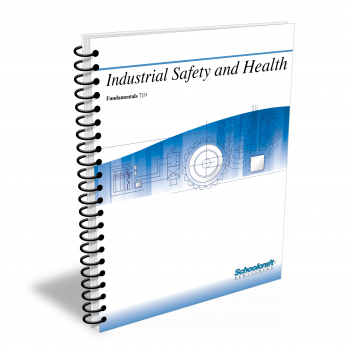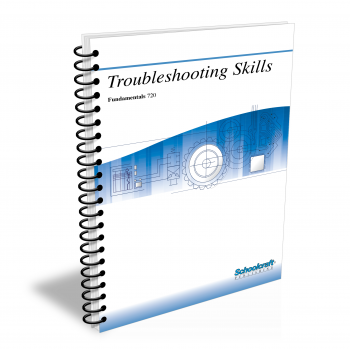Principles of Industrial Technology
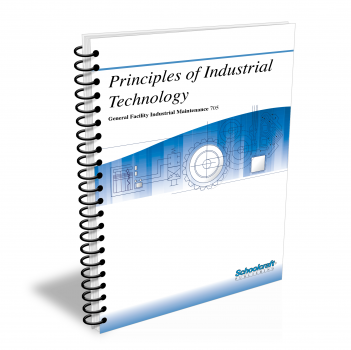
Course Number: 705
The Principles of Industrial Technology textbook was designed for a brief introductory course which touches on safety, measurement, blueprint reading, and other topics of interest.
Does your curriculum require additional topics not included in this textbook? Build a customized version of the Principles of Industrial Technology textbook below.
Recommended Contact Hours – 24
Preview a Chapter
Available Supporting Material
- Table of Contents
- Exam Copies
- Suggested Titles
Table of Contents
Chapter 1: Safety
Topics: Responsibility for safety; Unsafe acts and conditions; Recognizing hazards; Types of accidents; Investigation; Handling emergencies
Learning Objectives:
- Define the terms accident and hazard.
- Name and define the four main types of hazards.
- List and define various types of accidents.
- Compare meanings of the terms unsafe act and unsafe condition.
- Name the three ways in which a toxic substance can enter your body.
- List ways in which a company must plan for emergencies.
- Tell the main reason for prompt accident investigation.
Chapter 2: Measurement Principles
Topics: Length; Area; Volume; Angles; Time; Speed and velocity; Mass and weight; Force; Work and power; Pressure; Temperature; Electricity; Units; Measurement error; Tolerances; Scales and rules; Scribers and dividers; Bevel gauge; Calipers; Combination square; Using a micrometer
Learning Objectives:
- Identify various units of measurement.
- State the definition of the joule, the coulomb, and the horsepower.
- Explain how to calculate pressure.
- Explain the difference between mass and weight.
- Demonstrate how to measure the volume of an object.
- Explain the difference between the Celsius scale and the Fahrenheit scale.
- List five units used for making linear measurements.
- Demonstrate how to use a micrometer.
- Explain what each head of a combination square is used for.
- State the definition of parallax error.
- Define the different types of tolerance.
Chapter 3: Mechanical Drives
Topics: Couplings in industry; Coupling characteristics; Shaft alignment; Coupling hubs; Solid, jaw, molded rubber, chain, gear, metal disc, and metal grid couplings; Uses of belt drives; Belt drive terminology; V-belts; Timing and flat belts; Sheaves; Pulleys; V-belt installation; Chain drive terminology; Roller, double-pitch, leaf, silent, and steel drive chains; Cast chain drives; Sprockets; Chain drive installation
Learning Objectives:
- List three functions usually performed by a coupling.
- Name three kinds of misalignment.
- Describe two types of jaw couplings.
- Name an application for molded rubber couplings.
- State an advantage of chain type couplings.
- Name the factors that affect the power transmitted by a belt drive.
- List the main components of a belt drive.
- Name the standard V-belt designations.
- Explain the reason for group belts.
- Describe installation and replacement procedures for V-belts.
- Explain the main differences between chain drives and belt drives in transmitting power.
- Explain the operating principle of a roller chain drive.
- Describe the construction of offset roller chain.
- Explain the differences between sprocket types A, B, and C.
- List the steps in installing a chain drive.
Chapter 4: Blueprint Reading
Topics: Detail drawings; Notes and dimensions; Assembly and pictorial drawings; Orthographic projections; Auxiliary views; Sections; Simple machines; Screw threads; Heads; Rivets; Welds; Pins; Keys; Springs; Gears; Bearings; Belts and pulleys
Learning Objectives:
- Identify details, markings, and machine parts from an assembly drawing.
- Identify an object from an orthographic drawing.
- Identify elements located within the title block of a detail drawing.
- Explain why more than one orthographic projection is needed to show an object on a blueprint.
- Describe what a machine is, and explain what it does.
- Name the two basic methods of joining machine parts.
- Name and identify from an exhibit several types of threaded fasteners.
- Name the two basic methods of permanent joining.
- Identify gears, bearings, and belt drives on drawings.
- Identify types of screw threads from a specification.
Chapter 5: Reading Technical Diagrams
Topics: Using schematics; Electrical, pneumatic, hydraulic, and piping schematics; Looking for flow; Electrical current; Fluid flow; Common features in schematics; Creating and using the schematic; Identifying symbols and connections; Reading diagrams
Learning Objectives:
- State the definition of a schematic.
- List some characteristics of schematics.
- Identify a schematic among other kinds of technical drawings and diagrams.
- Explain how flow is indicated on a schematic.
- Identify various types of lines on schematics
- Identify the following schematics by their symbols:
Electrical
Fluid-power
Piping - Give the purpose of legends and other tables of symbols.
- Describe a set-by-step approach to troubleshooting when using a schematic.
Chapter 6: Piping Systems
Topics: Nature of fluids; Keeping fluids clean and moving; Piping system maintenance, insulation, and layout; Valves, fittings, supports, and hangers; Elbows, return bends, tees, cross-fittings, reducers, caps, plugs, and couplings; Screwed, welded, and flanged connections; Expansion joints; Vibration dampeners; Schematic symbols; Valve function, terminology, construction, and sizes; Gate, globe, needle, ball, butterfly, plug, check, and quick-opening valves; Connections and maintenance
Learning Objectives:
- Describe what typical piping systems consist of, and explain their importance to plant operations.
- Identify common valves and fittings, pipe hangers and supports.
- Describe the effects of temperature on piping system components, and explain the need for insulation.
- List routine maintenance considerations for piping systems.
- Discuss the main functions of fittings.
- Identify common pipe and tube fittings.
- Contrast screwed, flanged, and welded connections, and tell why one type of joint may be preferred for a given application.
- Explain how expansion joints and vibration dampeners work.
- Demonstrate a knowledge of the symbols used to represent joints and fittings on schematic drawings of piping systems.
- Explain the various ways in which valves control fluid flow in piping systems.
- Identify gate, globe, needle, ball, butterfly, plug, and check valves, and tell what each is used for.
- Explain how and why quick-opening valves are used in industrial piping applications.
- Describe routine inspection, lubrication, and maintenance procedures for common valves.
Chapter 7: Introduction to Hydraulics and Pneumatics
Topics: Force, weight, mass, pressure, work, power, and energy; Incompressibility; Nondiffusion; Hydrostatic pressure; Pascal's Law; Fluid power transmission; Bernoulli's principle; Fluid power systems; Force, weight, and mass; Pressure; Work and energy; Diffusion and dispersion; Compressibility; Laws of pneumatics; Leverage; Air properties and flow; Bernoulli's Law; Components
Learning Objectives:
- Explain the difference between absolute and gauge pressure.
- Demonstrate how power is calculated.
- Explain Pascal's Law.
- Describe the difference between laminar and turbulent flow.
- Name the main components of a hydraulic system.
- Explain how force is transmitted in a pneumatic system.
- Calculate force and work.
- List two factors that affect the results of pressure calculations.
- Explain pneumatic leverage.
- Briefly explain the physical laws affecting the behavior of a confined gas.
Request Exam Copies
Exam Copies
Ready to see a copy of our textbooks? After selecting which textbooks you’d like to review for your course, you can submit your request by either logging in or creating an account so we know where to ship your exam copies. A representative from Schoolcraft will contact you to confirm and finish processing your request.
Exam copies are always free and yours to keep.
Selected Exam Copies
none selected
* Maximum of five copies can be ordered
